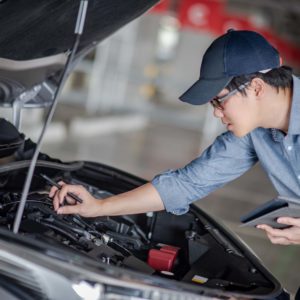A fuel-injected engine relies on the proper air-fuel ratio to run efficiently. The ratio is based on the oxygen (O2) sensor’s input on the amount of oxygen content in the exhaust.
An engine with an air-fuel ratio that’s too rich (too much fuel) won’t run properly and might trigger a P2180 code in the powertrain control module (PCM).
What Does the P2180 Code Mean?
Diagnostic trouble code (DTC) P2180 stands for “System Too Rich Off Idle.”
Using the input from O2 sensors, the PCM tries to achieve a stoichiometric air-fuel ratio. This ratio is the ideal mixture of fuel and oxygen and the compromise between maximum power and economy.

As the O2 sensor detects the concentration of oxygen in the exhaust gas, the PCM determines the right amount of air-fuel mixture by adjusting the fuel metering at the fuel injectors. This is made possible by using the zircon and platinum content of the O2 sensors to generate a voltage.
If a fault related to the O2 sensor occurs, the engine computer can produce a rich air-fuel mixture and log a P2180 code.
Note: The definition of code P2180 might be different depending on the vehicle manufacturer. Consult the appropriate repair manual or repair database for the exact code definition.
What are the Common Causes of the P2180 Code?

What are the Common Symptoms of the P2180 Code?
- Poor engine performance
- Poor fuel economy
How to Diagnose the P2180 Code
The P2180 code is a generic powertrain code that can be logged in most makes and models with on-board diagnostics (OBD). But the steps for diagnosis can vary, depending on the vehicle.
If you’re not familiar with the process of diagnosing trouble codes, it might be best to seek help from a professional to ensure that all steps and protocols are followed correctly. Otherwise, you can go ahead and do the job yourself.
How to Fix the P2180 Code
Fixing a P2180 code can be hard, especially if you’re not equipped with the right technical knowledge and skills for the job.
Under these circumstances, it might be best to take your vehicle to the nearest repair shop and let a professional address the problem. But if you think you have what it takes to work on your vehicle by yourself, make sure you have the right guides and tools before proceeding.
Guides like those from Chilton or an ALLDATA subscription contain vehicle-specific repair information, so you might want to check those out before you begin.
Any information provided on this Website is for informational purposes only and is not intended to replace consultation with a professional mechanic. The accuracy and timeliness of the information may change from the time of publication.


















